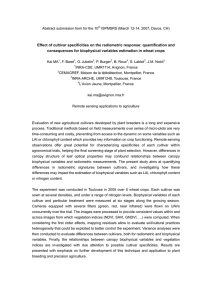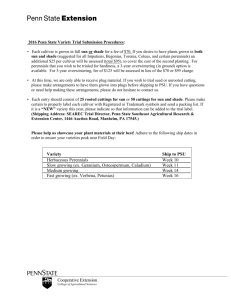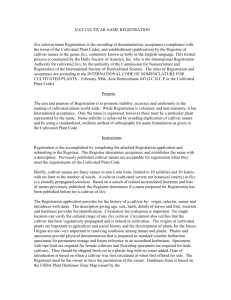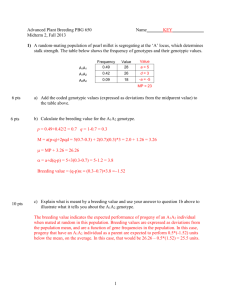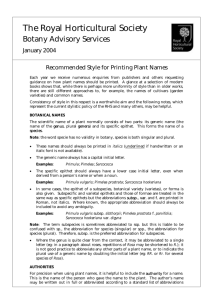ALUMINUM EFFECTS ON LIPID PEROXIDATION AND METABOLISM IN SORGHUM
advertisement
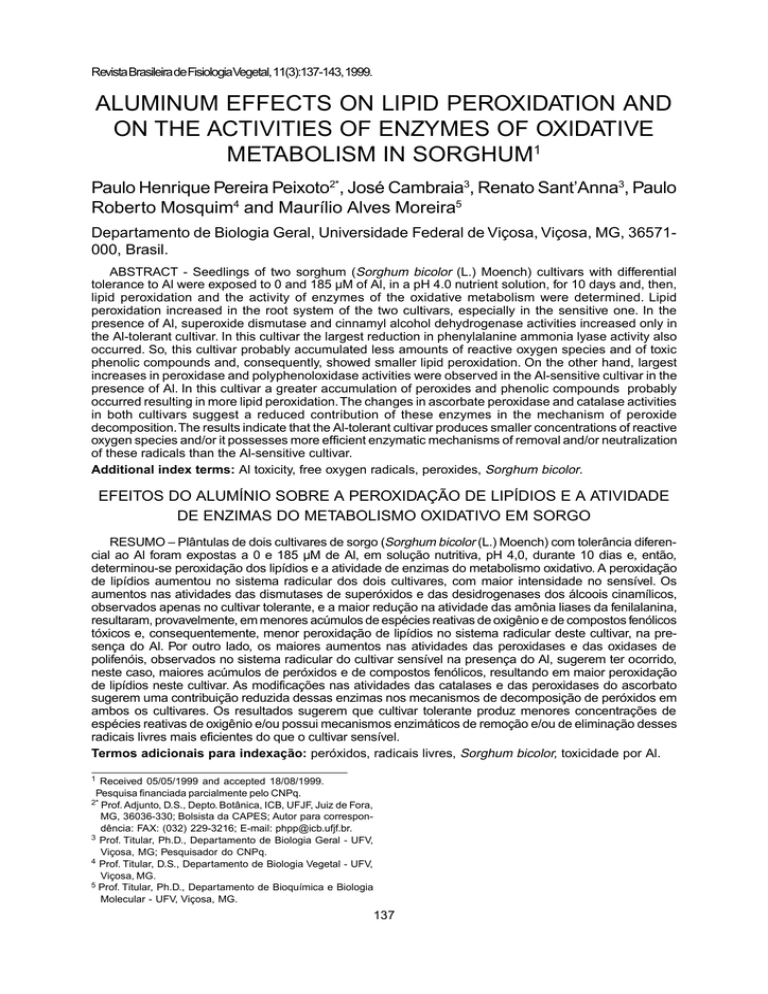
Revista Brasileira de FisiologiaVegetal, 11(3):137-143, 1999. ALUMINUM EFFECTS ON LIPID PEROXIDATION AND ON THE ACTIVITIES OF ENZYMES OF OXIDATIVE METABOLISM IN SORGHUM1 Paulo Henrique Pereira Peixoto2*, José Cambraia3, Renato Sant’Anna3, Paulo Roberto Mosquim4 and Maurílio Alves Moreira5 Departamento de Biologia Geral, Universidade Federal de Viçosa, Viçosa, MG, 36571000, Brasil. ABSTRACT - Seedlings of two sorghum (Sorghum bicolor (L.) Moench) cultivars with differential tolerance to Al were exposed to 0 and 185 µM of Al, in a pH 4.0 nutrient solution, for 10 days and, then, lipid peroxidation and the activity of enzymes of the oxidative metabolism were determined. Lipid peroxidation increased in the root system of the two cultivars, especially in the sensitive one. In the presence of Al, superoxide dismutase and cinnamyl alcohol dehydrogenase activities increased only in the Al-tolerant cultivar. In this cultivar the largest reduction in phenylalanine ammonia lyase activity also occurred. So, this cultivar probably accumulated less amounts of reactive oxygen species and of toxic phenolic compounds and, consequently, showed smaller lipid peroxidation. On the other hand, largest increases in peroxidase and polyphenoloxidase activities were observed in the Al-sensitive cultivar in the presence of Al. In this cultivar a greater accumulation of peroxides and phenolic compounds probably occurred resulting in more lipid peroxidation. The changes in ascorbate peroxidase and catalase activities in both cultivars suggest a reduced contribution of these enzymes in the mechanism of peroxide decomposition. The results indicate that the Al-tolerant cultivar produces smaller concentrations of reactive oxygen species and/or it possesses more efficient enzymatic mechanisms of removal and/or neutralization of these radicals than the Al-sensitive cultivar. Additional index terms: Al toxicity, free oxygen radicals, peroxides, Sorghum bicolor. EFEITOS DO ALUMÍNIO SOBRE A PEROXIDAÇÃO DE LIPÍDIOS E A ATIVIDADE DE ENZIMAS DO METABOLISMO OXIDATIVO EM SORGO RESUMO – Plântulas de dois cultivares de sorgo (Sorghum bicolor (L.) Moench) com tolerância diferencial ao Al foram expostas a 0 e 185 µM de Al, em solução nutritiva, pH 4,0, durante 10 dias e, então, determinou-se peroxidação dos lipídios e a atividade de enzimas do metabolismo oxidativo. A peroxidação de lipídios aumentou no sistema radicular dos dois cultivares, com maior intensidade no sensível. Os aumentos nas atividades das dismutases de superóxidos e das desidrogenases dos álcoois cinamílicos, observados apenas no cultivar tolerante, e a maior redução na atividade das amônia liases da fenilalanina, resultaram, provavelmente, em menores acúmulos de espécies reativas de oxigênio e de compostos fenólicos tóxicos e, consequentemente, menor peroxidação de lipídios no sistema radicular deste cultivar, na presença do Al. Por outro lado, os maiores aumentos nas atividades das peroxidases e das oxidases de polifenóis, observados no sistema radicular do cultivar sensível na presença do Al, sugerem ter ocorrido, neste caso, maiores acúmulos de peróxidos e de compostos fenólicos, resultando em maior peroxidação de lipídios neste cultivar. As modificações nas atividades das catalases e das peroxidases do ascorbato sugerem uma contribuição reduzida dessas enzimas nos mecanismos de decomposição de peróxidos em ambos os cultivares. Os resultados sugerem que cultivar tolerante produz menores concentrações de espécies reativas de oxigênio e/ou possui mecanismos enzimáticos de remoção e/ou de eliminação desses radicais livres mais eficientes do que o cultivar sensível. Termos adicionais para indexação: peróxidos, radicais livres, Sorghum bicolor, toxicidade por Al. 1 Received 05/05/1999 and accepted 18/08/1999. Pesquisa financiada parcialmente pelo CNPq. 2* Prof. Adjunto, D.S., Depto. Botânica, ICB, UFJF, Juiz de Fora, MG, 36036-330; Bolsista da CAPES; Autor para correspondência: FAX: (032) 229-3216; E-mail: phpp@icb.ufjf.br. 3 Prof. Titular, Ph.D., Departamento de Biologia Geral - UFV, Viçosa, MG; Pesquisador do CNPq. 4 Prof. Titular, D.S., Departamento de Biologia Vegetal - UFV, Viçosa, MG. 5 Prof. Titular, Ph.D., Departamento de Bioquímica e Biologia Molecular - UFV, Viçosa, MG. 137 Peixoto et al. 138 INTRODUCTION Aluminum (Al) is one of the major factors limiting growth and productivity of important crops in many acid soils throughout the world. Considerable research has been directed to elucidating the mechanisms of Al toxicity and plant tolerance in recent years, however, these processes are still poorly understood (Delhaize & Ryan, 1995; Kochian, 1995). One of the most important Al effects seems to be on the structure and function of the plasma membrane. Aluminum strongly binds to phospholipids, alters the total and relative abundance of phospholipids and other membrane lipids and changes the degree of fatty acid unsaturation (Zhang et al., 1996; 1997). There is also evidence that Al toxicity can cause excessive generation of reactive oxygen species (ROS) and an increase in peroxidation and/or breakdown of membrane lipids (Gutteridge et al., 1985; Cakmak & Horst, 1991; Ono et al., 1995). As a consequence, there is a significant modification in membrane permeability, ion transport and in the activity of a number of membranebound enzymes, especially H+-ATPase (Cooke & Burden, 1990). The reactive oxygen species, especially O2.- and H2O2, are commonly present in plant cells as a result of normal aerobic metabolism. Plants, however, usually possess mechanisms of cellular protection to keep these oxygen species below damaging levels, which include the action of several enzymes and/or the presence of some antioxidant substances (Scandalios, 1993). When plants are stressed (by high levels of Al for instance), however, the production and/or accumulation of reactive oxygen species can exceed the capacity of the scavenging systems, resulting in an increase in lipid peroxidation and, consequently, damages to plasma membrane structure and function (Gutteridge et al., 1985; Cakmak & Horst, 1991; Ono et al., 1995; Richards et al., 1998). The objective of this work was to evaluate the influence of Al on lipid peroxidation and the role of several enzymes of the oxidative metabolism in the production and/or degradation of reactive oxygen species, peroxides and other oxidative substances in two sorghum cultivars with differential tolerance to Al. MATERIALS AND METHODS Two sorghum cultivars (Sorghum bicolor (L.) Moench) obtained from the Centro Nacional de Pesquisas do Milho e do Sorgo (CNPMS/Embrapa), Sete Lagoas, MG, one Al-tolerant (BR006R), and the other Al-sensitive (BR007A) were studied. The seeds were surface sterilized with 0.5% sodium hypochlorite for 20 min, thoroughly rinsed with deionized water and then germinated in rolls of neutral pH “germtest” paper. After seven days, the seedlings were selected and transferred to polyethylene pots with 1.6 L of Clark’s nutrient solution, pH 4.0 (Clark, 1975), in the absence or presence of Al (185 µM of Al, as Al2(SO4)3.18 H2O salt). All experiments were conducted in a growth room with controlled temperature (25±3ºC), under photosynthetically active radiation of 230 µmoles m-2s-1, and a photoperiod of 16 hours. Volume and pH corrections of the nutrient solution were carried out daily and continuous aeration was supplied. Ten days after Al treatment, the seedlings were harvested, washed in deionized water, divided in shoot and root system and the fresh material used to evaluate lipid peroxidation, production of volatile aldehydes and enzyme assays. The experiments followed a 2 x 2 factorial arrangement: two sorghum cultivars, two Al levels, with three replicates. The results were subjected to an analysis of variance (ANOVA) and the means were statistically compared by Tukey’s test at 5%. Lipid peroxidation Samples of fresh material of 0.2 g were homogenized in 4 mL of 1% (w/v) trichloroacetic acid (TCA) solution. The homogenate was filtered through four layers of cheesecloth and then centrifuged at 12,000 g for 15 min. One mL aliquots of the supernatants were added to 3 mL of 0.5% (w/v) thiobarbituric acid (TBA) in 20% (w/v) TCA and the tubes were incubated in a shaking waterbath at 95 0C for 2 h. The reaction was stopped by placing the reaction tubes into an ice bath. The tubes were subsequently centrifuged at 9,000 g for 10 min, the absorbance of the supernatant was measured at 532 and 660nm (Cakmak & Horst, 1991) and the concentration of the malondialdehyde (MDA)-TBA complex produced was calculated using the molar extinction coefficient of 155 mM-1 cm-1. Production of volatile aldehydes Volatile aldehydes were extracted from 0.2 g of the root system and of the shoot fresh tissues in 5 mL of 2% (v/v) ethanol at 25 0C for 2 h, under constant stirring. One mL aliquot was transferred to a test tube containing 1 mL of 0.1% (m/v) 3-methyl-2-benzothiazolinone hydrazone (MBTH) and then 2.5 mL of 0.23% (m/v) FeCl3.6H2O was added. After 5 min of incubation, 6.0 mL of acetone was added and the absorbance read at 635 nm (Reis et al., 1989). The amount of volatile aldehyde produced was estimated using a formaldehyde calibration curve. Enzyme assays Two hundred mg of the root system and the shoot fresh tissues were homogenized in 10 mL of 0.1 M potassium phosphate buffer, pH 6.8, containing 0.1 mM EDTA. After filtration through four layers of cheesecloth, the homogenate was centrifuged at 12,000 g for 20 min and the supernatant was used as source of crude enzyme. All steps to obtain enzyme preparation were carried out at 4ºC. The activity of peroxidases (POX, EC 1.11.1.7) was determined by adding 100 µL of the crude enzyme preparation, diluted in the proportion of 1:25 (v/v), to 4.9 mL of a solution containing 25 mM potassium phosphate buffer, pH 6.8, 20 mM pyrogallol and 20 mM H2O2. After incubation of the solution at 250C for 1 min, the reaction was stopped by adding 0.5 mL of 5% (v/v) H2SO4 and the absorbance was read at 420 nm (Kar & Mishra, 1976). The enzyme activity was calculated using the molar extinction coefficient of 2.47 mM-1 cm-1. R. Bras. Fisiol. Veg., 11(3):137-143, 1999. Aluminum effects on lipid peroxidation . . . The activity of polyphenol oxidases (PPO, EC 1.10.3.2, EC 1.10.3.1 and EC 1.14.18.1) was determined using the same methodology described before (for POX) (Kar & Mishra, 1976) but omitting H2O2 from the reaction mixture. The enzyme activity was calculated as described before for POX. The activity of catalases (CAT, EC 1.11.1.6) was determined by adding 100 µL of crude enzyme preparation to 2.9 mL of a solution containing 12.5 mM H2O2 and 50 mM potassium phosphate buffer, pH 7.0, and by measuring the absorbance decrease at 240 nm, at 300C (Havir & McHale, 1987). The enzyme activity was calculated using the molar extinction coefficient of 36 M1 cm-1. The activity of superoxide dismutases (SOD, EC 1.15.1.1) was determined by adding 50 µL the crude enzyme preparation to a solution containing 13 mM metionine, 75 µM p-nitro blue tetrazolium chloride (NBT), 100 nM EDTA and 2 µM riboflavin in a 50 mM sodium phosphate buffer, pH 7.8 (Del Longo et al., 1993). The reaction took place in a chamber under illumination of a 15W fluorescent lamp kept inside a box covered with aluminum foil at 25ºC. The reaction was started turning the fluorescent lamp on and stopped 5 min later turning it off (Giannopolitis & Ries, 1977). The blue formazane produced by NBT photoreduction was measured by the increase in absorbance at 560 nm. The blank mixture had the same composition but it was kept in the dark. One SOD unit was defined as the amount of enzyme required to inhibit 50% of the NBT photoreduction. The activity of lipoxygenases (LOX, EC 1.13.11.12) was determined by adding 33 µL of the crude enzyme preparation (with no EDTA in the extraction medium) to a reaction mixture consisting of 4 µL of 10 mM sodium linoleate in 0.36% (v/v) Tween-20 and 2.0 mL of 50 mM sodium phosphate buffer, pH 6.0 (Axelrod et al., 1981). The absorbance increase at 234 nm was recorded during 1.5 min, at 250C, and the enzyme activity was calculated using the molar extinction coefficient of 25,000 M-1 cm-1. The crude enzyme preparation for ascorbate peroxidases (APX, EC 1.11.1.11) was obtained in similar way, but ascorbate was added to the extraction medium to obtain the final concentration of 1 mM. The activity of APX was determined by adding 100 µL of this crude enzyme preparation to 2.9 mL of a reaction medium containing 0.8 mM ascorbate and 1.0 mM H2O2 in 50 mM potassium phosphate buffer, pH 6.0. The absorbance decrease was measured at 290 nm, at 250C (Koshiba, 1993). The enzyme activity was calculated using the molar extinction coefficient of 2.8 mM-1 cm-1. The crude enzyme preparation for phenylalanine ammonia-lyases (PAL, EC 4.3.1.5) was obtained by homogenizing 0.15 g of fresh tissue in 15 mL of an extraction medium containing 20 mM β-mercaptoethanol, 0.1 M sodium borate buffer, pH 8.8, and 5% (m/v) insoluble polyvinylpyrrolidone (PVP). After filtration through four layers of cheesecloth, the homogenate was centrifuged at 12,000 g for 20 min. The enzyme activity was determined by adding 1 mL of the crude enzyme preparation to a reaction medium containing 1 mL of 0.2 M sodium borate buffer, pH 8.8, and 1 mL of 0.1 M L- 139 phenylalanine. After incubation for 1 h at 300C, the reaction was stopped by adding 0.1 mL of 6 N HCl and the absorbance was determined at 290 nm (Cahill & McComb, 1992). The enzyme activity was calculated using the molar extinction coefficient of 104 mM-1 cm-1. The crude enzyme preparation for cinnamyl alcohol dehydrogenases (CAD, EC 1.1.1.195) was obtained by homogenizing 0.2 g of fresh tissues in 3 mL of an extraction medium containing 40 mM β-mercaptoethanol and 100 mM potassium phosphate buffer, pH 7.3. The enzyme activity was determined by adding 200 µL this crude enzyme preparation to 2.8 mL of a reaction medium containing 100 µM sinapyl alcohol, 100 µM NADP+ and 100 µM Tris-HCl buffer, pH 9.3 (Mitchell et al., 1994). The increase of absorbance was measured at 340 nm, at 300C and the enzyme activity was calculated using the molar extinction coefficient 6.22 mM-1 cm-1. RESULTS AND DISCUSSION In the absence of Al, lipid peroxidation, measured by the MDA-TBA complex concentration in plant tissues, was statistically identical in both parts of the plants of the two cultivars (Figure 1, A). In the presence of Al, a considerable increase on lipid peroxidation was observed in the root system with a greater intensity in the Alsensitive cultivar (200%) when compared to the Al-tolerant one (126%). Under these conditions, the Al-sensitive cultivar showed a lipid peroxidation about 71% greater than the Al-tolerant cultivar. In the shoot, Al did not have a significant effect on lipid peroxidation in either cultivar and there was no difference between them. The results found in this experiment were similar to those obtained by Cakmak & Horst (1991) who also demonstrated lipid peroxidation in whole soybean roots after long-term Al treatments. According to these authors, Al alone is not capable of promoting lipid peroxidation if applied during short periods of time and at low concentration. The Al concentration and the exposure time used in this experiment were superior to those used by the previously mentioned authors. On the other hand, Ono et al. (1995) argue that oxidative alterations in membrane lipids could be the result of a combined action of Al and Fe, usually quite soluble in acid environments. According to Gutteridge et al. (1985), Al potentiates and/ or facilitates lipid peroxidation when it binds to the membrane phospholipids. Although some authors consider the lipid peroxidation more consequence than the primary cause of the Al toxic effects, there is evidence showing that Al promotes the oxidation of phenolic compounds which result in the production of O2.- and other oxygen toxic species that would potentiate lipid peroxidation (Cakmak & Horst, 1991). Since the MDA-TBA concentration found in the Alsensitive cultivar in the presence of Al was superior to that observed in the Al-tolerant cultivar and the toxic effects depend on their capacity and/or their efficiency to eliminate these active oxygen species, the results found here do not leave any doubt about the superiority of the Al-tolerant cultivar under stressing conditions. In the shoot, neither cultivar show significant changes in the lipid peroxidation intensity, probably because the Al R. Bras. Fisiol. Veg., 11(3):137-143, 1999. 140 Peixoto et al. 70 120 aA A 60 aA B aA 100 aA 50 aA aA aB 40 aA aB 80 60 aA aB aB 30 bA µ 20 40 bA bA 20 10 0 bB 0 Root syst em Shoot Root syst em Shoot FIGURE 1 – Aluminum effects on MDA-TBA complex (A) and volatile aldehyde (B) concentrations in tissues of root system and shoot of two sorghum cultivars. Al-sensitive, 0 µM of Al; Al-sensitive, 185 µM of Al; n Al-tolerant, 0 µM of Al; n Al-tolerant, 185 µM of Al. Means with the same small letters (in each cultivar, in absence and presence of aluminum) and by the same capital letters (between cultivars, in the absence and presence of aluminum) for each part of the plant do not statistically differ by the Tukey test at 5%. concentration was lower in this part of the plant (Gonçalves et al., 1996) and also because the root system seems to be more sensitive to the Al toxic effects (Cakmak & Horst, 1991). In the absence of Al, the volatile aldehyde concentration was greater in the Al-tolerant cultivar both in the root system and in the shoot (Figure 1, B). In the presence of Al, the volatile aldehyde concentration in the root system increased 6 and 2.4-fold in the Al-sensitive and Al-tolerant cultivars respectively. The volatile aldehyde concentration in the root tissues, which in the absence of Al was 93% greater in the Al-tolerant cultivar, became 29% greater in the Al-sensitive cultivar in the presence of this cation. In the shoot, Al had no significant influence on the production of volatile aldehydes in either cultivar, although the Al-tolerant cultivar showed an average of 47% more volatile aldehydes than the Al-sensitive one. Therefore, in this experiment, the most intense effect of Al on volatile aldehyde concentration was observed in the root system, especially in the Al-sensitive cultivar. Aldehydes are very harmful to the cellular metabolism, inhibiting enzymes, reducing the mitosis rate and inhibiting tubulin synthesis, required for the achromatic spindle formation (Wilson Jr. & McDonald Jr., 1986). The results obtained, which are quite similar to those indicated by the MDA-TBA test (Figure 1, A), strengthen the idea that Al in the nutrient solution or substances produced during Al treatment can cause greater peroxidative damages in the Al-sensitive cultivar than in the Al-tolerant one. In the absence of Al, POX activity in the root system was greater in the Al-sensitive cultivar but in the shoot there was no statistical difference between them (Figure 2, A). In the presence of Al, POX activity increased in the root system of both cultivars with a greater intensity in the Al-sensitive cultivar. In the shoot, an increase in the POX activity was also observed but with less intensity than in the root system and the cultivars did not differ statistically. Increase in POX activity in the presence of Al was also observed in soybean roots, especially after a long-term stress and under high Al concentrations (Cakmak & Horst, 1991). Apparently, Al activates a latent POX in tissues and/or induces the appearance of isoforms by an increase in the production of H2O2, phenolic compounds and/or hydroperoxides, important substrates for these enzymes (Siegel, 1993; Esaki et al., 1996). The activity of this enzyme depends not only on species, plant development stage and other factors (Siegel, 1993) but apparently also on the degree of Al toxicity, which is generally higher in the root system, as it has been verified in this experiment. In the absence of Al, APX activity in the root system was greater in the Al-tolerant cultivar but, in the shoot, it was greater in the Al-sensitive cultivar (Figure 2, B). In the presence of Al, a 34% increase in the enzyme activity was observed in the root system of the Al-sensitive cultivar but a 52% decrease in the Al-tolerant cultivar. Under these circumstances, the Al-sensitive cultivar exhibited an APX activity 54% greater than the Al-tolerant cultivar. In the shoot, the APX activity was reduced by Al treatment about 31% and 46% in the Al-sensitive and Al-tolerant cultivars, respectively. These results suggest that the Al-enhanced H2O2 production and/or accumulation in the root system of the Al-sensitive cultivar may have contributed to increase lipid peroxidation in membranes (Peixoto, 1998) and/or tissues of this cultivar (Figure 1, A and B). The largest APX activity observed in the presence of Al, especially in the root system of the Al-sensitive cultivar, strengthens the possibility that a greater accumulation of H2O2 in the tissues of this cultivar may be occurring. However, since the H2O2 concentration has not actually been measured, the ascorbate oxidation by phenolic compounds and, or the action of other non-specific enzymes cannot be discarded since the enzyme preparation has not been submitted to any kind of purification. R. Bras. Fisiol. Veg., 11(3):137-143, 1999. 141 Aluminum effects on lipid peroxidation . . . 30 1,4 1,2 aA A 25 aA B aA aA bB bA 1 20 aB bA 0,8 bB aA 0,6 aA 15 aA aB bB bA 10 bB 0,4 5 µ 0,2 0 0 Root syst em Shoot 0,7 0,6 Root syst em Shoot 600 aA D C aA 500 aA aA aA aB 0,5 400 0,4 aA aA aB aA 300 aA bB 0,3 bA bA bA 0,2 200 bB 100 0,1 0 0 Root syst em Shoot Root syst em Shoot 6 0,8 aA E F 5 aA 0,6 aA aB bA aA aA aA 4 aA 3 0,4 aB 2 0,2 aA bA bA ( 1 0 Root syst em bB aB 0 Root syst em Shoot Shoot 120 10 aA G 100 8 H aA aA 80 bA 6 bA aB bA bB aA aA 60 bB aA aA 4 40 2 aA aA 20 (µ aB aB 0 0 Root syst em Shoot Root syst em Shoot FIGURE 2 - Aluminum effects on the activities of oxidative enzymes in tissues of root system and shoot of two sorghum cultivars. Al-sensitive, 0 µM of Al; Al-sensitive, 185 µM of Al; n Al-tolerant, 0 µM of Al; n Al-tolerant, 185 µM of Al. Means with the same small letters (in each cultivar, in absence and presence of aluminum) and by the same capital letters (between cultivars, in the absence and presence of aluminum) for each part of the plant do not statistically differ by the Tukey test at 5%. R. Bras. Fisiol. Veg., 11(3):137-143, 1999. 142 Peixoto et al. In the absence of Al, no difference between cultivars was observed in the root system but in the shoot CAT activity was greater in the Al-tolerant cultivar (Figure 2, C). After Al treatment the enzyme activity decreased in both parts of the plant of both cultivars. In the shoot, the Al-tolerant cultivar showed an enzyme activity 22% higher than the Al-sensitive cultivar. Similar results have been obtained by Richards et al. (1998) who has also observed a reduction in specific mRNA for these catalases in Altreated plants. Increase in POX activity but reduction in CAT activity in the presence of Al indicate a higher consumption of H2O2 by oxidative processes rather than its removal by the action of enzymes of the detoxifying mechanism (Cakmak & Horst, 1991). The reduction in CAT activity observed in both parts of the plant of both cultivars, however, suggests a limited involvement of these enzymes in the H2O2 elimination mechanisms in response to Al toxicity. In the absence of Al, SOD activity in the root system was greater in the Al-sensitive cultivar but there was no difference between cultivars in the shoot (Figure 2, D). In the presence of Al, however, the enzyme activity increased only in the Al-tolerant cultivar (43%), and became 12% higher than in the Al-sensitive cultivar. In the shoot, the enzyme activity did not change in the presence of Al and there was no difference between the cultivars. The SOD activity was comparatively much greater than that of other enzymes. This seems to be necessary since O2.- and other reactive oxygen species are highly toxic to metabolism. So, plants usually maintain a higher SOD basal activity, which is important for cellular protection (Scandalios, 1993). The greater activity of SOD in the root system of the Al-tolerant cultivar in the presence of Al would probably result in an increase in H2O2 concentration demanding a larger participation of the enzymes of the H2O2 elimination system such as the membrane-bound POX, as suggested by Ezaki et al. (1996). Since the SOD activity in the root system of the Al-sensitive cultivar was not significantly changed by Al in the nutrient solution, the observed increase in APX in this par t of the plant (Figure 2, B) would be a consequence of ascorbate oxidation by phenolic compounds present in the nonpurified enzyme extracts. The PPO activity was not statistically changed in either part of the control plants of both cultivars (Figure 2, E). In the presence of Al, a 31% increase in enzyme activity was observed but only in the root system of the Al-sensitive cultivar. This increase suggests that production of some precursor of reactive oxygen species biosynthesis may be occurring. This possibility seems to be quite plausible since Al interferes with boron (Lukaszewski & Blevins, 1996) and zinc (Gonçalves et al., 1996) absorption, causing deviation in the pentose phosphate cycle that results in phenol production. This is usually followed by an increase in PPO activity (Marschner, 1995). In the absence of Al, the LOX activity was much greater in the root system and the Al-sensitive cultivar exhibited higher enzyme activity than the Al-tolerant cultivar in both parts of the plants (Figure 2, F). In the presence of Al, reductions of 85% and 77% were observed in the root system but increases of 120% and 150% were observed in the shoot of the Al-sensitive and Al-tolerant cultivars, respectively. Since lipid peroxidation increased in the roots of both cultivars in the presence of Al (Figure 1, A and B), an increase in the LOX activity was expected since the catabolic product of the action of these enzymes on polyunsaturated fatty acids are usually malonic aldehyde and other aldehydes (Gutteridge et al., 1985). However, it is important to point out that the enzyme activity assay was carried out only after ten days of Al treatment and probably is not exhibiting the average effect during the stress period. On the other hand, since Al concentration in the shoot is usually much lower than in the root system (Gonçalves et al., 1996), Al interference on the free radical elimination mechanisms and consequently on phenol accumulation was much lower, resulting in an increase in LOX activity. In the absence of Al, the Al-tolerant cultivar showed higher PAL activity than the Al-sensitive cultivar in both parts of the plant (Figure 2, G). In the presence of Al, the enzyme activity decreased 20% and 30% in the root system of the Al-sensitive and Al-tolerant cultivars, respectively. Under these conditions the Al-tolerant cultivar still showed 35% higher enzyme activity than the Al-sensitive cultivar. In the shoot, the enzyme activity did not change in the presence of Al but the Al-tolerant cultivar showed a significantly higher activity. The reduction of the PAL activity observed in the root system in the presence of Al in both cultivars may be the result of an inhibitory effect of accumulated phenolic compounds (Sato et al., 1982; Cahill & McComb, 1992) or of some kind of control mechanism operating in the transcription of this enzyme (Campbell & Sederoff, 1996). The greater reduction in the enzyme activity in the Al-tolerant cultivar may also have contributed to lower the intensity of lipid peroxidation of membranes (Peixoto, 1998) and tissues in this cultivar (Figure 1, A and B). In the absence of Al, there was no statistical difference in CAD activity between cultivars for both plant parts (Figure 2, H). In the presence of Al, a 17% reduction was observed in the CAD activity in the root system of the Al-sensitive cultivar, but a 38% increase in the Altolerant cultivar. In the shoot, the enzyme activity was not significantly changed by the presence of Al and there was no statistical difference between cultivars. The reduction in CAD activity in the root system of the Alsensitive cultivar caused by Al, though it may not be exactly reflecting the average activity with time of Al treatment, clearly indicates that Al may directly affect CAD or at least have an indirect effect by inducing Zn deficiency as suggested by Sarni et al. (1984). On the other hand, the increase observed in the Al-tolerant cultivar suggests that more lignification may be occurring in this cultivar. The Al-tolerant cultivar probably is using this strategy to reduce phenolic compounds and, or H2O2 accumulation, which are highly toxic to the cellular metabolism (Cakmak & Horst, 1991; Siegel, 1993). Monitoring changes in CAD and PAL activities will certainly allow a better understanding of the importance of these enzymes to lignification and to tolerance of plants to Al. R. Bras. Fisiol. Veg., 11(3):137-143, 1999. Aluminum effects on lipid peroxidation . . . The increase in CAD and SOD activities and also the greater reduction in PAL activity observed in the presence of Al probably resulted in lower O2.- and toxic phenols accumulation, reducing lipid peroxidation in the root system of the Al-tolerant cultivar. On the other hand, the greater increase in POX activity and the increase in PPO activity observed in the root system of the Al-sensitive cultivar in the presence of Al suggest that a larger H2O2 and toxic phenos accumulation may have occurred in this cultivar, resulting in an increased oxidative damage to its membranes (Peixoto, 1998) and tissues (Figure 1, A and B). Additionally, this would explain the larger reductions in CAD and LOX activities in the plants of this cultivar since such substances are potential inhibitors of these enzymes. The reductions observed in CAT activity in the root system of plants of both cultivars and in APX activity in the root system of the Al-tolerant cultivar in the Al presence suggest a reduced contribution of these enzymes in the peroxide decomposition mechanisms, strengthening the hypothesis that this toxic substance may be consumed especially in the peroxidative reactions under Al stress conditions. AKNOWLEDGEMENTS The authors acknowledge the financial support and fellowships of the Conselho Nacional de Pesquisa e Desenvolvimento Científico (CNPq), Brasília, DF, Brasil. REFERENCES AXELROD, B.; CHEESBROUGH, T.M. & LAAKSO, S. Lipoxygenase from soybeans. New York, Methods in Enzymology, 71:441-451, 1981. CAHILL, D.M. & McCOMB, J.A. A comparison of changes in phenylalanine ammonia-lyase activity, lignin and phenolic synthesis in the roots of Eucalyptus calophylla (field resistant) and E. marginata (susceptible) when infected with Phytophthora cinnamomi. Physiological and Molecular Plant Pathology, 40:315-332, 1992. CAKMAK, I. & HORST, J.H. Effects of aluminum on lipid peroxidation, superoxide dismutase, catalase, and peroxidase activities in root tips of soybean (Glycine max). Physiologia Plantarum, 83:463468, 1991. CAMPBELL, M.M. & SEDEROFF, R.R. Variation in lignin content and composition. Mechanisms of control and implications for genetic improvement of plants. Plant Physiology, 110:3-13, 1996. CLARK, R.B. Characterization of phosphatase of intact maize roots. Journal of Agricultural and Food Chemistry, 23:458- 460, 1975. COOKE, D.T. & BURDEN, R.S. Lipid modulation of plasma membranebound ATPases. Physiologia Plantarum, 78: 153-159, 1990. DEL LONGO, O.T.; GONZÁLEZ, C.A.; PASTORI, G.M. & TRIPPI, V.S. Antioxidant defenses under hyperoxygenic and hyperosmotic conditions in leaves of two lines of maize with differential sensitivity to drought. Plant and Cell Physiology, 34:1023-1028, 1993. DELHAIZE, E. & RYAN, P.R. Aluminum toxicity and tolerance in plants. Plant Physiology, 107:315-321, 1995. EZAKI, B.; TSUGITA, S. & MATSUMOTO, H. Expression of a moderately anionic peroxidase is induced by aluminum treatment in tobacco cells: possible involvement of peroxidase isozymes in aluminum ion stress. Physiologia Plantarum, 96:21-28, 1996. GIANNOPOLITIS, C.N. & RIES, S.K. Superoxide dismutases. I. Occurrence in higher plants. Plant Physiology, 59:309-314, 1977. 143 GONÇALVES, J.F.C.; CAMBRAIA, J.; SANT’ANNA, R. & PACHECO, S. Aluminum and zinc effects on the metabolism of ribonucleic acid in two sorghum cultivars. Revista Brasileira de Fisiologia Vegetal, 8:81-86, 1996. GUTTERIDGE, J.M.C.; QUINLAN, G.J.; CLARK, I. & HALLIWELL, B. Aluminium salts accelerate peroxidation of membrane lipids stimulated by iron salts. Biochemical and Biophysical Acta, 835:441-447, 1985. HAVIR, E.A. & McHALE, N.A. Biochemical and developmental characterization of multiple forms of catalase in tobacco leaves. Plant Physiology, 84:450-455, 1987. KAR, M. & MISHRA, D. Catalase, peroxidase, and polyphenoloxidase activities during rice leaf senescence. Plant Physiology, 57:315319, 1976. KOCHIAN, L.V. Cellular mechanisms of aluminum toxicity and resistance in plants. Annual Review of Plant Physiology and Plant Molecular Biology, 46: 237-260, 1995. KOSHIBA, T. Cytosolic ascorbate peroxidase in seedlings and leaves of maize (Zea mays). Plant and Cell Physiology, 34:713-721, 1993. LUKASZEWSKI, K.M. & BLEVINS, D.G. Root growth inhibition in boron-deficient or aluminum-stressed squash may be a result of impaired ascorbate metabolism. Plant Physiology, 112:11351140, 1996. MARSCHNER, H. Mineral nutrition of higher plants. 2nd. ed., London, Academic Press, 1995. 889 p. MITCHELL, H.J.; HALL, J.L. & BARBER, M.S. Elicitor-induced cinnamyl alcohol dehydrogenase activity in lignifying wheat (Triticum aestivum L.) leaves. Plant Physiology, 104:551-556, 1994. ONO, K.; YAMAMOTO, Y.; HACHIYA, A. & MATSUMOTO, H. Synergistic inhibition of growth by aluminum and iron of tobacco (Nicotiana tabacum L.) cells in suspension culture. Plant and Cell Physiology, 36:115-125, 1995. PEIXOTO, P.H.P. Peroxidação de lipídios em membranas e tecidos de dois cultivares de sorgo (Sorghum bicolor (L.) Moench) com tolerância diferencial ao alumínio. Viçosa, Universidade Federal de Viçosa. 1998. 95p. Tese de Doutorado. REIS, W.J.P.; ROCHA, V.S.; REZENDE, S.T.; MOREIRA, M.A. & SEDIYAMA, C.S. Correlação entre a evolução de n-hexanal e aldeídos totais e a germinação e vigor de sementes de soja. Revista Ceres, 36:27-37, 1989. RICHARDS,K.D.; SCHOTT, E.J.; SHARMA, Y.; DAVIS, K.R. & GARDNER, R.C. Aluminum induces oxidative stress genes in Arabidopsis thaliana. Plant Physiology, 116:409-418, 1998. SARNI, F.; GRAND, C. & BOUDET, A.M. Purification and properties of cinnamoyl-CoA reductase and cinnamyl alcohol dehydrogenase from poplar stems (Populus x euramericana). European Journal of Biochemistry, 139:259-265, 1984. SATO, T.; KIUCHI, F. & SANKAWA, U. Inhibition of phenylalanine ammonia-lyase by cinnamic acid derivatives and related compounds. Phytochemistry, 21:845-850, 1982. SCANDALIOS, J.G. Oxygen stress and superoxide dismutases. Plant Physiology, 101:7-12, 1993. SIEGEL, B.Z. Plant peroxidase - an organismic perspective. Plant Growth Regulation, 12:303-312, 1993. WILSON JR., D.O. & McDONALD JR., M.B. A convenient volatile aldehyde assay for measuring soybean seed vigor. Seed ScienceTechnology, 14:259-268, 1986. ZHANG, G.; SLASKI, J.J.; ARCHAMBAULT, D.J. & TAYLOR, G.J. Aluminum-induced alterations in lipid composition of microsomal membranes from an aluminum-resistant and an aluminumsensitive cultivar of Triticum aestivum. Physiologia Plantarum, 96: 683-691, 1996. ZHANG, G.; SLASKI, J.J.; ARCHAMBAULT, D.J. & TAYLOR, G.J. Alteration of plasma membrane lipids in aluminium-resistant and aluminium-sensitive wheat genotypes in response to aluminium. Physiologia Plantarum, 99:302-308, 1997. R. Bras. Fisiol. Veg., 11(3):137-143, 1999.
